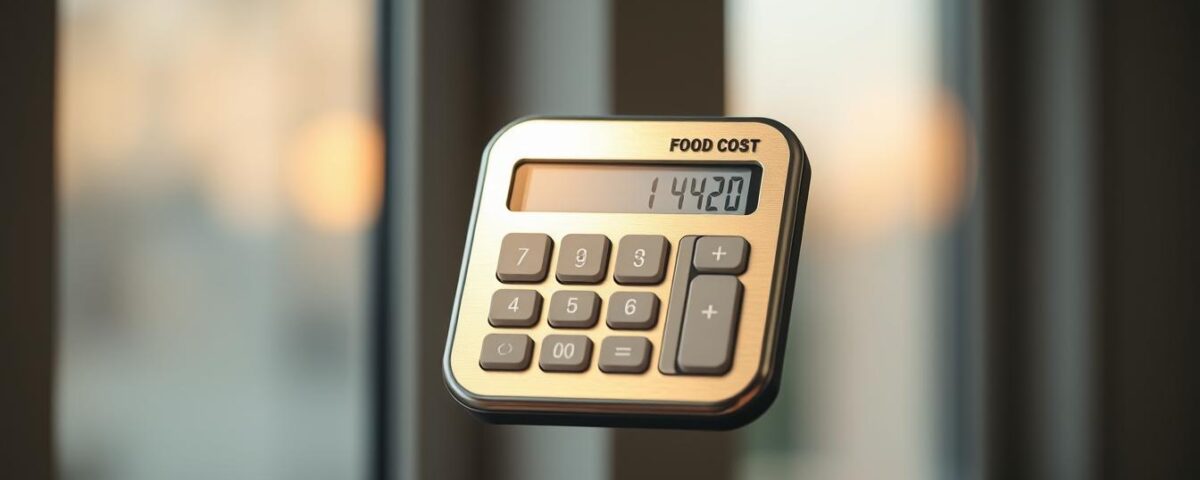
How to Boost Your Restaurant Profit Margin Above Industry Average
August 22, 2025
The Secret Software That’s Saving Restaurants Thousands in Waste
August 23, 2025Running a restaurant or food business can be a challenging endeavor, especially when it comes to managing profitability. I recall a small café owner who struggled to understand why their profits were dwindling despite a steady stream of customers. Upon closer inspection, it turned out that their food cost percentage was significantly higher than the industry average.
Did you know that the foodservice industry typically operates on thin profit margins of only 3-5%? This means that even a small miscalculation in food costs can significantly impact your bottom line. By using a food cost calculator, you can gain precise insights into your menu costs and make informed decisions to boost profitability.
So, how can you quickly and accurately determine your food costs to stay ahead of the competition?
Key Takeaways
- Learn how to use a food cost calculator to determine your actual and target costs.
- Understand the importance of food cost percentage in maintaining profitability.
- Discover how to price menu items strategically to maximize profits.
- Find out how to calculate food costs for any dish in under 5 minutes.
- Gain insights into managing your recipe costing process effectively.
Why Food Cost Calculations Matter for Your Business
In the competitive restaurant industry, precise food cost calculations can make or break a business. With food businesses operating on thin profit margins – usually between 3 to 5% – keeping each of these expenses as low as possible is crucial.
Effective food cost management directly impacts your bottom line. Let’s explore the significance of accurate food cost calculations and common challenges faced by restaurants.
The Impact on Your Profit Margins
Accurate food cost calculations help you understand the profitability of your menu items. By knowing the exact cost of each dish, you can set menu prices that ensure a healthy profit margin. For instance, a small variation in ingredient costs can significantly affect your overall profitability.
| Menu Item | Ingredient Cost | Selling Price | Profit Margin |
|---|---|---|---|
| Grilled Chicken | $3.50 | $15.00 | 76.7% |
| Veggie Burger | $2.80 | $12.00 | 76.7% |
| Salmon | $4.20 | $18.00 | 76.7% |
Common Challenges in Food Cost Management
Managing food costs can be challenging due to various factors. Some common issues include inconsistent recipe execution, seasonal ingredient price fluctuations, and failure to account for all ingredients in recipes.
- Inconsistent recipe execution leads to variable food costs.
- Seasonal ingredient price changes can disrupt your food cost calculations.
- Omitting small ingredients can result in underestimating food costs.
Understanding the Food Cost Calculator
A food cost calculator is an essential tool for any restaurant or food service business looking to optimize their menu pricing and profitability. It helps you determine your target food cost and actual food cost, ensuring you’re on track to achieve your desired profit margins.
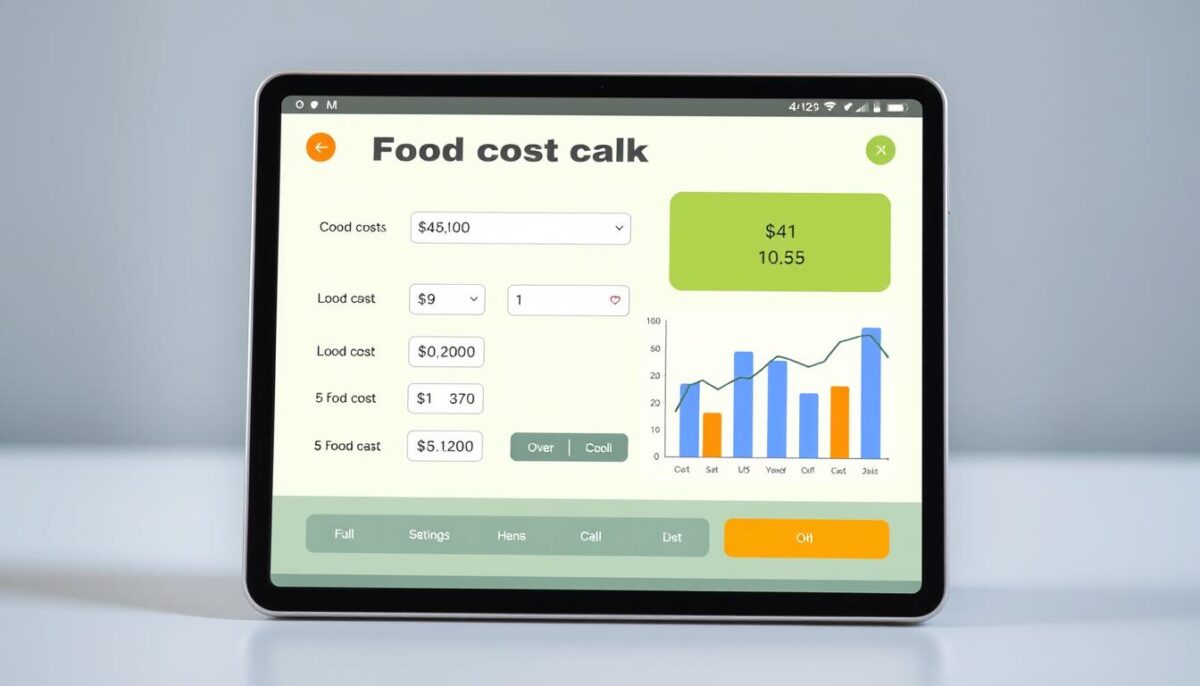
Key Components of Food Cost Calculations
To effectively use a food cost calculator, you need to understand its key components, including cost percentage, food cost percentage, and selling price. These elements work together to help you determine your menu pricing and profitability.
Target Food Cost vs. Actual Food Cost
It’s crucial to differentiate between target food cost and actual food cost. Your target food cost is the ideal cost you aim for, while your actual food cost is what you’re really spending. For instance, if your menu price is $80, your target food cost might be $40 to maintain your margin. Regularly comparing these two figures helps you identify execution issues in the kitchen and make necessary adjustments.
Some key points to consider:
- I always emphasize the difference between target food cost (what you aim for) and actual food cost (what you’re really spending).
- Your target food cost percentage should align with your overall business model and the type of establishment you operate.
- Fine dining restaurants typically aim for food cost percentages between 28-32%, while fast-casual concepts might target 25-30%.
- Regularly comparing target versus actual food costs helps identify execution issues in the kitchen.
- Understanding this relationship helps you determine whether to adjust your menu prices or find ways to reduce ingredient costs.
- The gap between target and actual food costs often reveals opportunities for staff training, portion control improvements, or menu engineering.
Gathering Your Recipe Information
To effectively utilize a food cost calculator, gathering accurate recipe information is crucial. This involves several key steps that help you understand your menu item costs and pricing strategy.
Essential Ingredients Data to Collect
To start, you’ll need to collect detailed data on the ingredients used in your recipes. This includes the quantity and cost of each ingredient. Accurate ingredient costing is vital for determining the total cost of your dishes.
Organizing Your Menu Pricing Strategy
When organizing your menu pricing strategy, consider factors like your target market’s price sensitivity and perceived value expectations. Categorizing your menu items by food cost percentage can help identify which items need price adjustments.
| Menu Item | Food Cost Percentage | Selling Price |
|---|---|---|
| Grilled Chicken | 25% | $15 |
| Veggie Burger | 30% | $12 |
| Salad Bowl | 20% | $10 |
By analyzing your menu pricing and costs, you can create a balanced menu that maximizes profitability while remaining competitive.
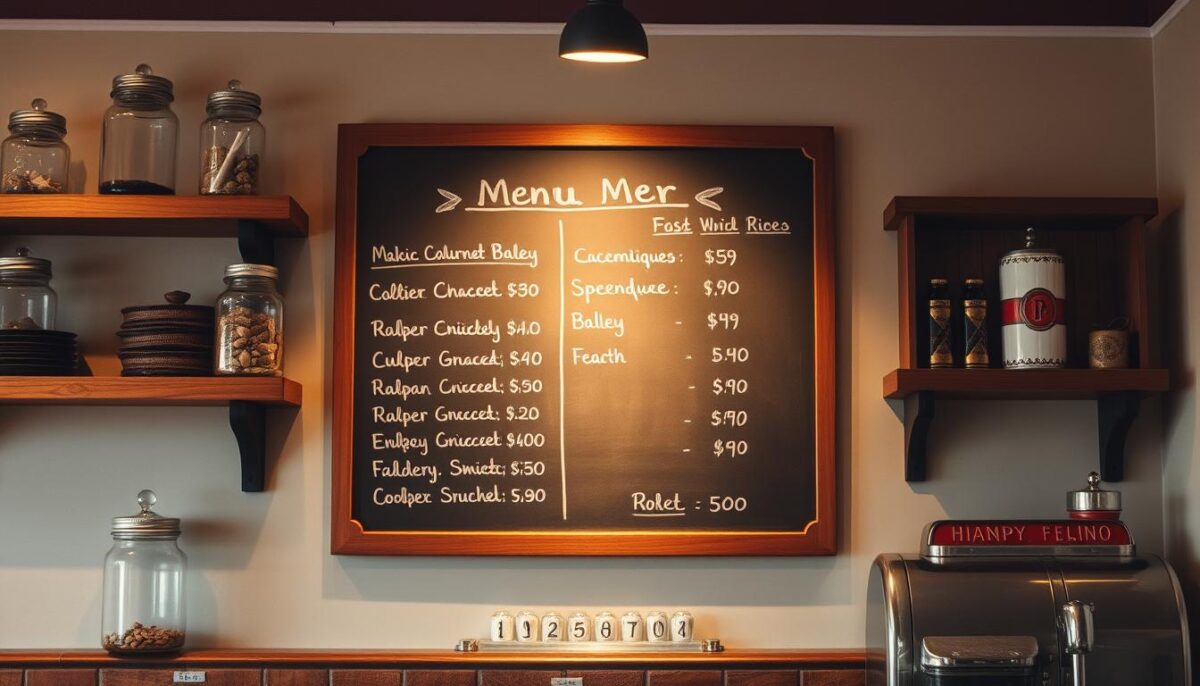
Step-by-Step Guide to Using a Food Cost Calculator
I find that a food cost calculator is an indispensable tool for determining the profitability of my menu items. By following a few simple steps, I can ensure that my menu is both competitive and profitable.
Entering Your Menu Item Details
The first step is to enter the details of your menu item into the cost calculator. This includes the name of the dish and the number of servings it yields. Accurate data entry is crucial for obtaining reliable results.
Adding Ingredient Costs and Quantities
Next, I add the costs and quantities of the ingredients used in the recipe. This involves listing each ingredient along with its cost and the quantity used. The calculator will then use this information to calculate food costs.
Calculating Your Results
Once I’ve entered all the necessary information, the calculator provides a detailed breakdown of the costs. This includes the total recipe cost, cost per serving, and suggested selling price. Understanding the breakdown helps me identify areas where I can optimize my menu pricing.
| Metric | Description | Example Value |
|---|---|---|
| Total Recipe Cost | Combined cost of all ingredients | $50 |
| Cost Per Serving | Total cost divided by number of servings | $5 |
| Suggested Selling Price | Based on markup percentage | $15 |
| Food Cost Percentage | (Cost per serving / Selling price) * 100 | 33.33% |
By using a food cost calculator, I can easily determine my food cost percentage and make adjustments to improve profitability. The key is to regularly update the ingredient costs and quantities to reflect current market prices.
Interpreting Your Food Cost Results
Now that you’ve used a food cost calculator, let’s dive into what the results mean for your business. Understanding your food cost results is crucial for optimizing your menu pricing strategy and enhancing overall profitability.
Understanding Your Food Cost Percentage
Your food cost percentage indicates the proportion of your revenue spent on ingredients for a particular item. For instance, if your food cost percentage is 40%, this means that for every dollar sold, 40 cents goes towards the cost of ingredients.
Analyzing Expected Profit and Selling Price
When analyzing your selling price, consider not just the food cost percentage but also the absolute profit dollar amount per dish. The ideal selling price balances profitability with what your target customers are willing to pay. As an example, if you spend $50 on ingredients and aim for a 40% food cost, your expected selling price should be set at $125 to achieve the desired margin.
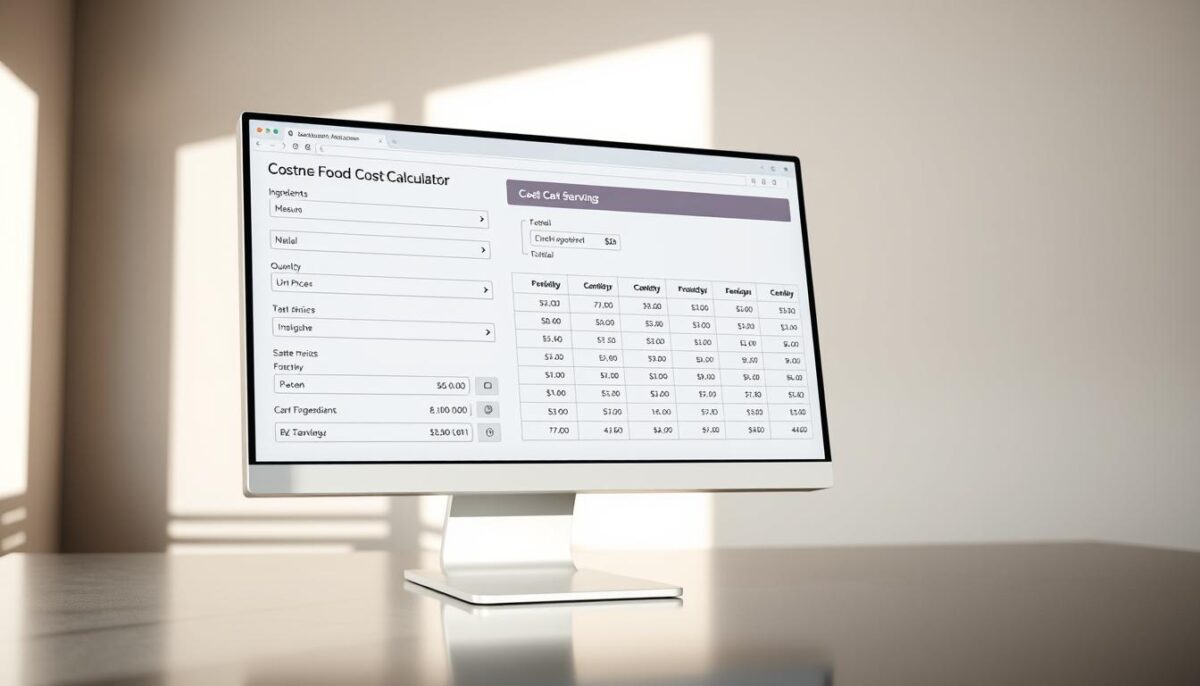
Making Adjustments to Improve Profitability
Now that you have your food cost calculations, let’s explore strategies to enhance your business’s profitability. With your food cost results, you can identify areas for improvement and implement changes to increase profitability.
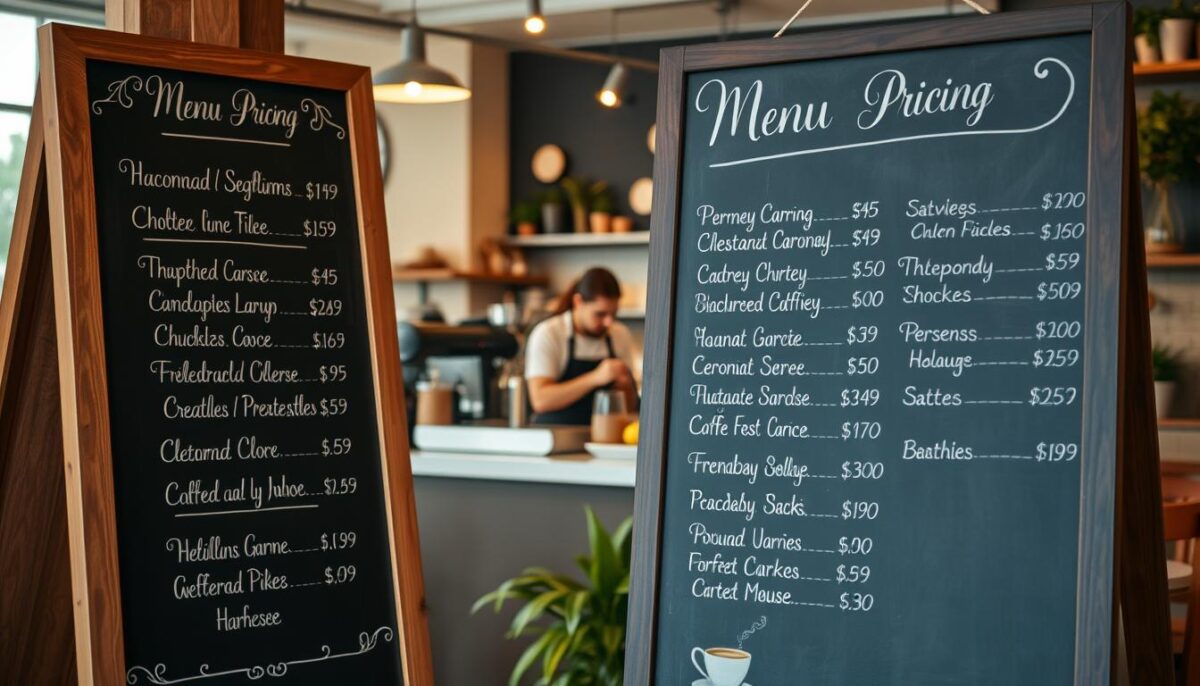
Strategies to Lower Food Costs
To lower food costs, I recommend analyzing your recipe costs and identifying underpriced items that could benefit from strategic price increases. Menu engineering techniques can help categorize items by popularity and profitability, guiding your pricing optimization strategy. By making smaller, more frequent price changes, you can avoid shocking your customers.
Optimizing Menu Pricing Based on Results
When optimizing menu pricing, consider using strategic price positioning, such as .95 or .99 endings, to influence customer perception while improving margins. Highlighting value through menu descriptions and presentation can also justify higher prices when necessary. Testing price elasticity by adjusting prices on select items helps determine your customers’ sensitivity to price changes, enabling you to make informed decisions about your menu pricing strategy.
Conclusion
To maintain optimal profitability, it’s vital to regularly assess your food costs. By using a food cost calculator, you can transform your approach to menu pricing and profitability in just minutes. This tool enables you to make informed decisions that directly impact your bottom line.
Implementing the strategies outlined will help you maintain optimal food costs while maximizing your profit potential. I encourage you to start with just one menu item today and experience how quickly you can calculate your food costs using a reliable cost calculator.
By investing just a few minutes per recipe in food cost calculations, you’re setting your business up for long-term financial success. The insights gained from proper food cost analysis will inform better purchasing, menu design, and pricing decisions, ultimately enhancing your overall business operations.
FAQ
How do I determine the ideal food cost percentage for my restaurant?
To determine your ideal food cost percentage, consider your restaurant’s profit margins, menu pricing, and target audience. Typically, a food cost percentage between 28% and 35% is considered standard, but this can vary depending on your specific business model.
What factors can affect my actual food cost percentage?
Several factors can impact your actual food cost percentage, including ingredient costs, waste management, and menu engineering. Fluctuations in ingredient prices, over-preparation, and inefficient menu design can all contribute to higher food costs.
How often should I update my food cost calculations?
I recommend updating your food cost calculations regularly, ideally every week or month, to ensure you’re staying on top of changes in ingredient prices, menu item popularity, and other factors that can impact your profitability.
Can I use a food cost calculator for multiple menu items?
Yes, you can use a food cost calculator for multiple menu items. Simply input the ingredient costs and quantities used for each dish, and the calculator will provide you with the total food cost and profit margin for each item.
How can I lower my food costs without sacrificing quality?
To lower your food costs without sacrificing quality, consider implementing strategies like menu optimization, portion control, and supplier negotiation. You can also explore alternative ingredients or vendors to reduce costs.
What is the difference between target food cost and actual food cost?
Your target food cost is the ideal percentage you’re aiming for, while your actual food cost is the real percentage based on your current ingredient costs, menu pricing, and other factors. Comparing these two numbers helps you identify areas for improvement.
